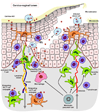Preventing mucosal HIV transmission with topical microbicides: challenges and opportunities
- PMID: 21109065
- PMCID: PMC3032991
- DOI: 10.1016/j.antiviral.2010.09.011
Preventing mucosal HIV transmission with topical microbicides: challenges and opportunities
Abstract
A combination of prevention and treatment modalities will be needed to successfully control the global spread of HIV. Microbicides, drug products topically applied to mucosal surfaces to prevent HIV infection, are one of these biomedical interventions that hold great promise. In order to be efficacious, microbicides must overcome several challenges imposed by the mucosal microenvironment they intend to protect and the mischievous human immunodeficiency virus with its enormous capacity to adapt. Recent data, however, supports the establishment of the primo-infection by only a small number of founder viruses, which are highly vulnerable to microbicidal intervention at the initial stages of mucosal invasion. The biological foundation of these challenges and opportunities in microbicide development is explored in this review. This article forms part of a special supplement on presentations covering HIV transmission and microbicides, based on the symposium "Trends in Microbicide Formulations", held on 25 and 26 January 2010, Arlington, VA.
Keywords: HIV mucosal infection; HIV prevention; HIV transmission; Microbicides; sexually transmitted infections.
Copyright © 2010 Elsevier B.V. All rights reserved.
Figures

References
-
- Berlier W, Bourlet T, Lawrence P, Hamzeh H, Lambert C, Genin C, Verrier B, Dieu-Nosjean MC, Pozzetto B, Delezay O. Selective sequestration of X4 isolates by human genital epithelial cells: Implication for virus tropism selection process during sexual transmission of HIV. J Med Virol. 2005;77:465–474. - PubMed
-
- Berlier W, Cremel M, Hamzeh H, Levy R, Lucht F, Bourlet T, Pozzetto B, Delezay O. Seminal plasma promotes the attraction of Langerhans cells via the secretion of CCL20 by vaginal epithelial cells: involvement in the sexual transmission of HIV. Hum Reprod. 2006;21:1135–1142. - PubMed
Publication types
MeSH terms
Substances
Grants and funding
LinkOut - more resources
Full Text Sources
Medical

